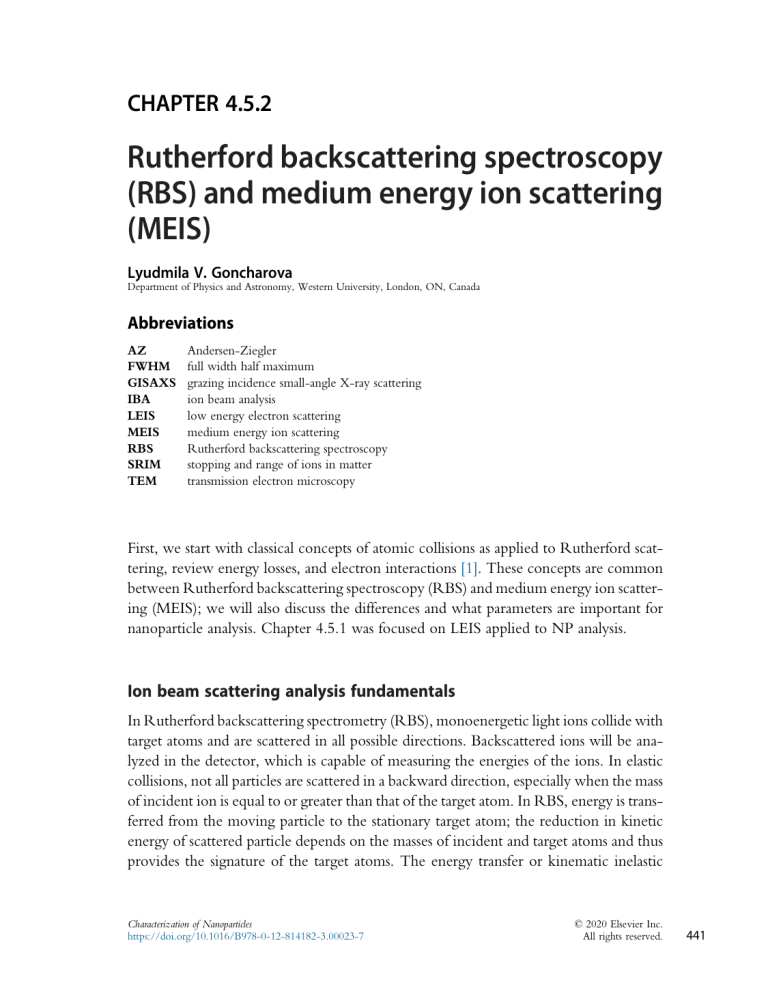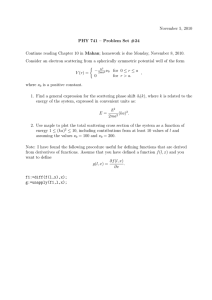
CHAPTER 4.5.2 Rutherford backscattering spectroscopy (RBS) and medium energy ion scattering (MEIS) Lyudmila V. Goncharova Department of Physics and Astronomy, Western University, London, ON, Canada Abbreviations AZ FWHM GISAXS IBA LEIS MEIS RBS SRIM TEM Andersen-Ziegler full width half maximum grazing incidence small-angle X-ray scattering ion beam analysis low energy electron scattering medium energy ion scattering Rutherford backscattering spectroscopy stopping and range of ions in matter transmission electron microscopy First, we start with classical concepts of atomic collisions as applied to Rutherford scattering, review energy losses, and electron interactions [1]. These concepts are common between Rutherford backscattering spectroscopy (RBS) and medium energy ion scattering (MEIS); we will also discuss the differences and what parameters are important for nanoparticle analysis. Chapter 4.5.1 was focused on LEIS applied to NP analysis. Ion beam scattering analysis fundamentals In Rutherford backscattering spectrometry (RBS), monoenergetic light ions collide with target atoms and are scattered in all possible directions. Backscattered ions will be analyzed in the detector, which is capable of measuring the energies of the ions. In elastic collisions, not all particles are scattered in a backward direction, especially when the mass of incident ion is equal to or greater than that of the target atom. In RBS, energy is transferred from the moving particle to the stationary target atom; the reduction in kinetic energy of scattered particle depends on the masses of incident and target atoms and thus provides the signature of the target atoms. The energy transfer or kinematic inelastic Characterization of Nanoparticles https://doi.org/10.1016/B978-0-12-814182-3.00023-7 © 2020 Elsevier Inc. All rights reserved. 441 442 Characterization of nanoparticles Fig. 1 Diagram of the elastic collision between projectile of mass M1, velocity vo and energy Eo, and a target mass M2, initially at rest. After the collision, the projectile and the target masses have velocities and energies v1, E1 and v2, E2, respectively. collisions between two isolated particles can be solved fully by applying the conservation of energy and momentum in two dimensions, as shown in the diagram in the succeeding text (Fig. 1). Initially an incident energetic particle of mass M1 has velocity v0 and energy E0 and target atom of mass M2 is at rest. After the collision, the values of the velocities v1 and v2 the projectile, and the target atom trajectories are determined by the scattering angle, θ, and recoil angle, ϕ, as presented in Fig. 1. Conservation of energy and conservation of momentum parallel and perpendicular to the direction of incidence can be expressed by the following equations: 1 1 1 M1 v02 ¼ M1 v12 + M2 v22 2 2 2 M1 v0 ¼ M1 v1 cos θ + M2 v2 cos φ 0 ¼ M1 v1 sin θ M2 v2 sin φ (1) (2) (3) By solving these equations, eliminating ϕ, then v2, we can find the ratio of the ion velocities: h i 2 2 2 1=2 M2 M1 sin θ + M1 cosθ v1 ¼ (4) M1 + M2 v0 If M1 < M2, the plus sign holds, and the ratio of the projectile energies is " #2 1=2 M22 M12 sin 2 θ + M1 cosθ E1 k¼ ¼ M2 + M1 Eo (5) The energy ratio is also called the kinematic factor, k, and it shows that the energy after a single collision is determined only by the masses of the particle and target atom and scattering angle, θ. The plot of the calculated kinematic factor, k, versus scattering angle for proton (H+) scattering shows a dispersion as a function of target atom mass RBS and MEIS between a value of 1 and those at scattering angles approaching 0 degree. The larger separation between dispersion curves is achieved at larger scattering angles (approaching 180 degrees); this is why the backward geometries (detectors at θ ¼ 150–170 degrees) are typically used in most common RBS experiments. Note that the dispersion curves will be separated better if He ions or heavier projectiles are utilized as incident particles. Medium energy ion scattering (MEIS) is a lower energy and high-resolution version of RBS. MEIS is based on the same physical principles as RBS; however, it offers the advantage of superior depth resolution while maintaining the same data interpretation as for RBS. In many cases, MEIS can give quantitative information about sample composition and surface structure on the nanometre scale [2]. When energetic ions traverse through the solid material, they will lose their energy by electronic excitations and interaction with nuclei. Although such energy losses are very small compared with the energy of the incident particle, these effects combined with sufficient energy resolution in the detector are what gives MEIS excellent depth profiling capabilities. There are two separate stopping mechanisms at the energy of MEIS: electronic stopping (inelastic atomic collisions) and nuclear stopping (elastic nuclear collisions). As shown earlier, the kinematics of the nuclear collisions result in relatively large energy losses. However, these events are rare in the MEIS regime. The predominant energy loss mechanism is due to electronic stopping. When H+ or He+ ions move through matter, they lose energy through interactions with electrons that are raised to excited states or even ejected from atoms. When the projectile velocity is much greater than that of the orbital electron, the influence of the incident particle on a stationary atom can be considered as a small perturbation, leading to the stopping theory of Bohr. This approximation works well for the energies in MeV range. The MEIS regime falls into a transitional region, making it Hf0.67Si0.33O2/SiOxNy /Si(001) o Hf + E (H ) = 130.8 keV Yield Scat. angle = 125.3 o x10 Si O C 100 N 105 110 115 120 125 130 H+ energy (keV) Fig. 2 MEIS backscattering spectrum for a 3.0-nm thick Hf silicate thin film on Si(001) substrate with SiOxNy at the interface. Spectrum is acquired in channelling direction with incident beam aligned with [001] direction in the substrate. 443 444 Characterization of nanoparticles difficult to get stopping parameters exclusively from theory. Empirical corrections, such as Andersen-Ziegler (AZ) values, or numerical calculations (e.g. the stopping and range of ions in matter (SRIM) code) are frequently used [3,4]. Fig. 2 shows a backscattering proton (H+) energy spectrum from the surface of a 3-nm thick Hf silicate layer deposited on Si(001) using atomic layer deposition [5]. Note that all elements (masses) are clearly resolved on the energy scale. This example also reveals an important aspect of mass resolution: energy resolution is best when the energy transfer from the ion to the target is large. Most of the MEIS (RBS) energy spectra are acquired at higher scattering angles where all elemental peaks are well resolved. Having established the means by which ion scattering can determine what element is on the surface, the next question is the quantitative content or concentration of the element. The measured integrated peak intensities for individual elemental peaks express scattering yields and are strongly dependent on the atomic number of the element. Quantification of individual element fractions can be done, since Rutherford scattering cross sections, σ, are known with high precision and can be estimated using Eq. (6): 12 0 B Z1 Z2 e2 C dσ C σ ðθÞ ¼ B @ θ A dΩ 2 4E sin 2 (6) where Z1 and Z2 are atomic numbers of the incident ions and target atoms, e is the elementary charge, E is the energy of incident ion during collision, and θ is the scattering angle. Note that RBS sensitivity will increase with increasing Z1, increasing Z2, and decreasing E. This is the scattering cross section originally derived by Rutherford and often referred to as ‘Rutherford’ cross section. The integrated peak intensity Ai for each element at the sample surface can be calculated using Eq. (7): Ai ¼ ðNt Þi Q Ω ðσ ðE, θÞ= cos θÞ (7) where (Nt)i is the areal density, in atoms per unit area; Q is the ion beam dose or fluency; Ω is the solid angle of the detector; and σ(E, θ)/cos θ is the cross section of element normalized by the factor (cos θ) associated with scattering geometry. Ion dose (fluency), the number of incident particles (collected charge), is measured using a Faraday cup and calculated as Q ¼ I t. The solid angle stays constant for a particular detector and slit combinations and, in practice, needs to be verified by the calibration standard measurements. To determine quantitative information on the amount of the various elements at the surface, that is, the surface composition, it is important to understand that a large fraction of ions leaving the surface are positively charged. For heavy elements on the surface, the charged fraction of exiting ions can be estimated using a surface barrier detector (capable RBS and MEIS of detecting energetic particles of all charges and neutrals) combined with a set of electrostatic plates, which can steer away charged particles, placed in front of the detector. By measuring integrated intensity of particles scattered from near-surface layer with and without a voltage applied on the steering plates, the charged fraction can be determined. Because of the need to obtain accurate information about integrated peak intensity in ion beam methods, several research groups conducted studies to quantify charge fractions on the light ions on a target-by-target basis [6]. Several general conclusions can be drawn about the neutralization of H+ and He+ ions exiting the surface in the MEIS energy range (30–200 keV). First, the charge fraction is only dependent on the exit energy, there is no memory of the incident energy or direction or of the element it collided with. So, charged fractions need to be measured accurately for various ions, elements, and exit energies. Second, there is no significant variation (above 10%) of the results between the different metal surfaces. There is an empirical curve (Eq. 8) that provides good agreement with experimental data for the most metal surfaces. It provides a reasonable estimate for situations where the charge fractions of positive ions, f +, cannot be measured [7]: f + ¼ 0:947 0:609 exp ½ðEe 17:6Þ=54:2 (8) where Ee is the exit energy, in keV. Finally, changes in the chemical state of the surface can influence the charged fraction; the velocity of ions exiting from the surface has to be matched with the velocity and density of electrons that contribute to neutralization. For ions in the medium energy range (50–400 keV), Eq. (7) will be modified to include effects of charge fraction, f +. Ai ¼ ðNt Þi Q Ω ðσ ðE, θÞ= cos θÞ f + (9) After scattering from the surface region of a sample, ions in a horizontal scattering plane are collected into a toroidal electrostatic analyzer (TEA), Fig. 3. Ions are steered inside the detector by a high voltage applied to the deflection plates, arriving at the position-sensitive detector (PSD), which determines their angle and energy. The distance between the sample and entrance slits on the detector, the distance between the exit slit and PSD, and the radius of curvature are optimized to provide two key focusing characteristics of the TEA [8]. To analyze the energy and angle of the ions passing through the TEA, a pair of multichannel plates are mounted in a chevron arrangement, with chargedividing collector on the back. Notably, the total system instrumental energy resolution with TEA detector for 100-keV H+ is typically 120 eV. The total system energy resolution is usually close to 190–250 eV, which includes contributions from the incident energy broadening and intrinsic effects of the proton-Au interactions [9]. Another important phenomenon frequently explored in ion beam analysis in general and MEIS in particular is channelling. One can understand channelling by simply considering atomic arrangement of the crystal lattice aligned along major crystallographic direction, as shown, for instance, in Fig. 4A. If incident ion beam is aligned along a major 445 Fig. 3 Toroidal ion energy analyzer (High Voltage Engineering, Amersfoort, The Netherlands). Sample is illustrated with blue cylinder (dark grey in print version) with the incident beam and outgoing (scattered) particles shown with red arrows (dark grey in print version). If the optional 2D positionsensitive detector is used, no exit slit is used. (Adapted from https://aac.kist.re.kr.) Fig. 4 SrTiO3 lattice viewed along the [001] channelling direction (A) and in random direction (B). (C) Comparison of MEIS spectra in the channelling (black) and random (red; grey in print version) geometry with two Sr peaks (surface and interface SrSi2) is resolved. When an incident beam is aligned with a low-index crystal axis of the film, the energy spectrum of backscattered ions represents mostly contributions from the exposed atoms in the surface or disordered interface layers. RBS and MEIS crystallographic direction, the deflection of ions from the surface atoms leads to the formation of a shadow cone, and therefore, very small fraction of scattering is coming from deeper atoms. Residual yield from the bulk of the crystalline (epitaxial) film originates from dechannelling effects related to thermal vibrations, possible crystal disorders, multiple scattering, or interface disorder. Interface chemical composition can be easier to resolve in a channelling geometry compared with ‘random’ alignment (Fig. 4B), when all atoms are visible to the ion beam. With most of the ions channelling into a crystalline film, only collisions with surface atoms result in backscattering, giving rise to the so-called surface peak in the energy spectrum. This is why for epitaxial SrTiO3 films on Si(001) substrate, the signal from Sr, Ti, and O in Fig. 4C can be described by narrow Sr, Ti, and O surface peaks at 93.5, 90.5, and 78.5 keV. A disordered layer at the SrTiO3/Si(001) interface gives rise to additional Sr and Si peaks, at 92 and 85 keV. Overall, the channelling effect leads to a severe reduction in backscattering yields, compared with the yield in random geometry shown by red line (grey in print version) in Fig. 4C [10]. Applications of RBS and MEIS in the measurement of NP ensembles: Case studies Case study #1: MEIS analysis of the structure of Au(core)/Pd(shell) nanoparticles used for catalysis Metal nanoparticles (NPs) grown on oxide substrates have attracted much attention as effective heterogeneous catalysts. Recently, it was shown that bimetallic core/shell NPs exhibit higher catalytic activity than the individual monometallic particles [11]. MEIS has been applied successfully to confirm the formation of a core/shell structure and to determine the average diameter of the core and the shell [12,13]. As an example, Au(core)/Pd(shell) nanoparticles with a size (outer diameter) of 2.4 or 3.7 nm prepared by an alcohol reduction technique and deposited on a ZnS(001) substrate mounted on a sample holder in vacuum were analyzed using 120-keV He+ incident ions [12]. The structure of core/shell NPs is analyzed in such way that the observed MEIS spectrum is modelled by constructing a spectrum assuming a sphere with diameter d, as the shape of the core/shell NPs neglecting weak physisorption interactions between NPs and ZnS(001) substrate. In MEIS spectrum simulations, the core/shell spheres were divided into a number of small cubes with a side length of 0.05–0.1 nm [13]. The energy spectrum for He+ ions scattered from metal atoms j in the nth cube (with volume, v) is given by Aj n ðE Þ ¼ fS ðEout ðnÞ EÞ ðct Þj v Q Ω ðσ ðE, θÞ= cos θÞ f + (10) where fS(Eout(n) E) is the asymmetry factor, (ct)j is the number density of the atom element j, Q is the number of incident particles, Ω is the solid angle of the detector, (σ(E, θ)/cos θ) is the scattering cross section, and f + is the He+ fraction. In this case, an exponentially 447 448 Characterization of nanoparticles (A) (B) Fig. 5 (A) MEIS spectrum (open circles) observed for 120.5-keV He+ incident on Pd(shell)/Au(core) nano-objects prepared by reduction in alcohol. The thick red curve denotes the best-fit spectrum obtained by assuming Pd/Au atomic ratio of 5/4 and the bimodal distribution shown in (B). The thin green and orange curves (dark grey and light grey in print version). correspond to the scattering components from smaller and larger size groups of NPs, respectively. The dark yellow and blue curves (grey and dark grey in print version) are for the spectra obtained a monomodal size distribution (core diameter 2.0 nm, shell diameter 2.7 nm, size dispersion (FWHM) 25%) and alloyed particles (diameter 2.1 nm and size dispersion (FWHM) 25%). (Adapted with permission from H. Matsumoto, K. Mitsuhara, A. Visikovskiy, T. Akita, N. Toshima, Y. Kido, Au(core)/Pd(shell) structures analyzed by high-resolution medium energy ion scattering, Nucl. Instrum. Methods Phys. Res. Sect. B 268(13) (2010), 2281–2284.) modified Gaussian profile was applied as an asymmetric line shape of scattering component from each small cube, which can be described as an asymmetry factor dependent on the incident, emerging energy, and energy spread with exact equation given in Ref. [12]. Fig. 5A shows the MEIS spectrum measured from Au(core)/Pd(shell) NPs with a Pd/ Au atomic ratio of 1/1 (from preparation conditions) and average outer diameter roughly estimated to be 2.4 nm (TEM). TEM could not resolve the core/shell structure in this RBS and MEIS Fig. 6 Simulated MEIS spectra as a function of outer diameter assuming 120-keV He+ incidence and outgoing angles of 45 degrees for (A) Pd(shell)/Au (core) and (B) Au(shell)/Pd(core) NP compositions. (Adapted with permission from H. Matsumoto, K. Mitsuhara, A. Visikovskiy, T. Akita, N. Toshima, Y. Kido, Au (core)/Pd(shell) structures analyzed by high-resolution medium energy ion scattering, Nucl. Instrum. Methods Phys. Res. Sect. B 268(13) (2010), 2281–2284.) case. Note that formation of Au–Pd alloy can be ruled out (blue solid curve; dark grey in print version). The dark yellow curve (grey in print version) was obtained assuming a monomodal size distribution and core and shell diameters of 2.0 and 2.7 nm, respectively, with a standard deviation of 25% (FWHM). Monomodal distribution does not produce good fit to the tails of Au experimental peaks. The best consistency between results and simulations was obtained with bimodal distribution: contributions from the groups with a larger and smaller sizes are shown in orange and green curves (light grey and dark grey in print version). More details on the size distributions are given in Fig. 5B. Simulated MEIS energy spectra as a function of outer diameter for Pd(shell)/Au(core) and Au(shell)/Pd(core) nanoparticles were produced to predict the limit of detection (Fig. 6). As it is shown here, the energy width for each component from Au and Pd can be correlated with the core and shell diameter. Fig. 6 indicates that this MEIS analysis can be applied for NPs with a size ranging from 1 to 5 nm,which is often challenging for conventional TEM. For larger particle sizes, the Au and Pd peaks overlap [12]; however, it would be possible to overcome this limit by measurements at larger incident energy. Case study #2: MEIS, TEM, and GISAXS characterization of Pb nanoparticles buried in a SiO2/Si interface There are numerous examples where nanoparticles have to be embedded in a solid matrix as a part of preparation or to ensure chemical and mechanical stability of the nanoparticle array. It becomes more challenging to obtain information on their shapes, size, and size distribution under such conditions. A detailed microstructural characterization for NPs arrangements in a matrix is usually obtained via TEM or grazing incidence small-angle X-ray diffraction (GISAXS) measurements [14,15]. Furthermore, accurate elemental compositions of those embedded NPs are required and can be provided by ion beam analysis methods, including RBS and MEIS [16–18]. 449 450 Characterization of nanoparticles Fig. 7 High-resolution TEM micrograph (A) of a [011] oriented Si wafer sample presenting a crosssectional view of the Pb nanoparticles partially embedded within the SiO2/Si interface on top of the Si wafer. (B) Zoom out view showing Si NPs density. (Adapted with permission from D.F. Sanchez, F.P. Luce, Z.E. Fabrim, M.A. Sortica, P.F.P. Fichtner, P.L. Grande, Structural characterization of Pb nanoislands in SiO2/Si interface synthesized by ion implantation through MEIS analysis, Surf. Sci. 605(7–8) (2011) 654–658.) This example describes how MEIS was applied to characterize buried 2D NP systems that attracted interest in connection with plasmonic or magnetic applications. The 200-nm SiO2/Si(001) wafer was placed in ultrahigh vacuum on a temperature-controlled stage. The NP samples were prepared by Pb+ ion implantation at 300 keV to place the Pb ions at the 200-nm SiO2/Si(001) interface. To ensure their uniform depth distribution, implantation was followed by an ageing treatment (T ¼ 200°C, 100 h) in air and a high-temperature annealing (T ¼ 1100°C, 1 h) in high vacuum [17]. Fig. 7A shows a high-resolution TEM micrograph in cross section, demonstrating that Pb nanoparticles are partially embedded in the Si substrate. The Pb NPs (Fig. 7) present a hemispherical shape at the SiO2 side and a polygonal shape within the Si (001) matrix, as schematically presented in Fig. 8. Selected area diffraction TEM patterns indicate that the NPs are mostly single crystal and have epitaxial arrangement with Si. This epitaxial alignment justifies the alignment of the square-shaped basis with respect to the substrate lattice. RBS and MEIS Fig. 8 The pyramidal frustum (PF) geometrical shape model is described by three parameters: the radius, the angle θ, and the depth, h. The NP anisotropy observed in the TEM is taken into account and is related to (110) and (010) Si plane directions. A side-view perspective at (A) the (110) and (C) (010) directions of the Si substrate and (B) and (D) a top views. (Adapted with permission from reference D.F. Sanchez, F.P. Luce, Z.E. Fabrim, M.A. Sortica, P.F.P. Fichtner, P.L. Grande, Structural characterization of Pb nanoislands in SiO2/Si interface synthesized by ion implantation through MEIS analysis, Surf. Sci. 605(7–8) (2011) 654–658.) The MEIS measurements were performed using 100-keV He+ ions with 0 degree incidence on the surface and TEA detector centred at a scattering angle of 120 degrees. Fig. 9A presents experimental and simulated MEIS 2-D (energy vs angle) spectra for the thinner (44 nm SiO2) and thicker (61 nm of SiO2) samples. Note that scattering intensity corresponding to Pb has some arc- and rainbow-like features, coming from the fact that NP is not on the surface but rather buried at the interface. MEIS energy spectra were simulated using PowerMEIS software [19]. Simulations were performed for Pb areal densities of 3.5 1011 cm2, close to the value from TEM images (within 10%). Notably, the shape of the NPs was modelled as pyramidal frustum (PF), with the parameters described in Fig. 8. In particular, base heights h ¼ 2 nm, a radius of 3.71 nm, and angle between (001) and (111) Si plane directions were considered. MEIS spectra were also analyzed through simulations at fixed scattering angles by looking at particular scattering 451 Characterization of nanoparticles Experiment Simulation Thin sample Thick sample 84 82 20.00 Pb Pb 110° 110° 115° 115° 120° 120° 125° 125° 129° 129° 131° 131° 80 78 76 74 72 Si 66 64 62 74 Si Si Pb 72 Pb 70 68 Counts Si 68 Relative scattering intensity 70 Energy (keV) 452 66 64 62 60 58 0 56 110 (A) 115 120 125 130 110 115 120 Scattering angle (deg) 125 130 63 (B) 67 71 75 79 83 57 61 65 69 73 Energy (keV) Fig. 9 (A) 2D MEIS spectra for the thinner (44-nm SiO2) and thicker (61 nm of SiO2) samples. (B) MEIS energy spectra at the fixed angles for the thinner and thicker samples. Red lines (grey in print version) represent the simulated spectra, and the dark grey dots are the experimental data. Blue open circle (grey in print version) curves include multiple scattering effects. (Adapted with permission from D.F. Sanchez, F.P. Luce, Z.E. Fabrim, M.A. Sortica, P.F.P. Fichtner, P.L. Grande, Structural characterization of Pb nanoislands in SiO2/Si interface synthesized by ion implantation through MEIS analysis, Surf. Sci. 605 (7–8) (2011) 654–658.) angle data in the 110–130 degrees range (Fig. 9B). The simulation results are mostly in good agreement with experimental MEIS data, except for the smaller scattering angles, where effects of multiple scattering are more significant. NP diameters and shapes can be calculated with the methodologies described in this work for the range between 2 and 10 nm. Geometrical shapes, for example, spherical or PF, can also be distinguished for the larger particles. Overall, this is one of the examples where MEIS measurements can provide rather accurate statistical information on the NP sizes and shapes. Case study #3: RBS analysis of the structure of Au(core)/Ag(shell) nanoparticles used for plasmonic applications The poor depth resolution of RBS of typically 10 nm at the sample’s surface limits the range of its applications for NP characterization. However, there are many interesting examples where RBS constitutes a useful tool to confirm depth distribution of NP embedded in a thin film [20], alloyed or dealloyed bimetallic core/shell NPs [21]. Among Au- and Ag-based RBS and MEIS Fig. 10 (A) Schematics of synthesis of core–shell Au@Ag NPs aiming on a shell separated from the core by a dendrimer inter layer. The 20-nm citrate-stabilized Au NP core is covered by [G1]OH peptide dendrimers. (B) Schematic presentation of the three possible model structures for the Au/ Ag interface. (C) Measured Rutherford backscattering spectra the alloying Au–Ag islands case (red dots; dark grey in print version) and (Au [G1]OH)core—Agshell, the separated layers case (orange circles; light grey in print version). (Adapted with permission from reference A. Lataifeh, H.B. Kraatz, L.V. Goncharova, Core-shell nanoparticles containing peptide dendrimers, J. Inorg. Organomet. Polym. Mater. 28 (2) (2018) 457–462.) core–shell NPs, the use of Aucore/Agshell would be more beneficial, since Ag component has better optical properties for plasmonic applications. The extinction coefficient of Ag NPs could be four times larger than that of Au NPs of the same size and shape. Encapsulation of spherical, triangular and rod-shaped Au core with Ag shell has been demonstrated; however, in most of the cases, Au–Ag alloying instead of core–shell NP formation was observed. It was shown by Lataifeh et al. [21] that dealloying of bimetallic Au core–Ag shell NPs can be achieved using peptide dendrimers of various lengths and 453 454 Characterization of nanoparticles compositions, as shown in Fig. 10A. NP samples were prepared for analysis by drop cast of diluted NP solutions on Si(001) wafer and transfer to the vacuum chamber. Elemental depth profiles for the core–shell NPs at various stages of preparation were examined by RBS, with 2-MeV He+. For some dendrimer compositions, the Ag shell has never been fully separated from the Au core, leading to the formation of Ag islands on the Au core (Fig. 10B). RBS spectra were modelled using other alternative core–shell structures, as also shown in Fig. 10B, including alloyed and Ag shell/dendrimer/Au core structures. For the cases of Ag island formation and alloying, one should observe the corresponding Au surface peak at 1.850 MeV. The RBS spectra have unequivocally excluded alloying of Au and Ag for some dendrimer compositions (Fig. 10C) [21]. Summary of capabilities and limitations No single NP characterization technique can provide all the answers to questions regarding NP size, size distribution, or chemical composition. Majority of the reported results in this field comes from a combination of complementary methods. RBS and MEIS are no exception to this rule. The major strong points of MEIS and RBS stem from their abilities to provide both structural and compositional information for a variety of NP systems. The data interpretation is straightforward, as it comes from scattering in real space as opposed to reciprocal space diffraction. With the energy resolution of the MEIS as reported earlier, depth profiling and compositional analysis are done with 4–5 Å depth resolution, very close to a single-layer resolution for some favourable examples. There are advantages of MEIS with respect to RBS and LEIS, for the purpose of measurement of NP size and composition. Ions of lower energy can be characterized by an electrostatic detector, with improved resolution. If one lowers energy even further, in LEIS range, multiple scattering and resonant neutralization effects make quantification more difficult. However, surface sensitivity is maximized, and information at ultimate surface sensitivity can be extracted easily. Ion beam analysis methods also have several limitations and challenges. Foremost, among the disadvantages of RBS and MEIS is the complexity of the setup: One needs an accelerator (which is expensive), calibration of detector, and electronic system, and also, the software is not trivial to use. Ion beam analysis (IBA) methods cannot provide direct information of the chemical state of surface atoms, as can be done by various complementary electron spectroscopies that are described in separate chapters in this book. References [1] T.L. Alford, L.C. Feldman, J.W. Mayer, Fundamentals of Nanoscale Film Analysis, Springer, New York, NY, London, 2007. [2] B.W. Busch, W.H. Schulte, T. Gustafsson, C. Uebing, Layer-resolved depth profiling at single crystal surfaces, Nucl. Instrum. Methods Phys. Res. B 183 (1–2) (2001) 88–96. RBS and MEIS [3] S.N. Dedyulin, M.P. Singh, F.S. Razavi, L.V. Goncharova, Energy loss of protons in SrTiO3 studied by medium energy ion scattering, Nucl. Inst. Meth. B 288 (2012) 60–65. [4] M. Brocklebank, S.N. Dedyulin, L.V. Goncharova, Stopping cross sections of protons in Ti, TiO2 and Si using medium energy ion scattering, Eur. Phys. J. D 70 (11) (2016) 7. [5] L.V. Goncharova, M. Dalponte, D.G. Starodub, T. Gustafsson, E. Garfunkel, P.S. Lysaght, G. Bersuker, Diffusion and interface growth in hafnium oxide and silicate ultra-thin films on Si (001), Phys. Rev. B 83 (2011) 115329. [6] R. Haight, L.C. Feldman, T.M. Buck, W.M. Gibson, Neutralization of energetic He ions scattered from clean and Cs-covered Si(100), Phys. Rev. B 30 (2) (1984) 734–740. [7] B. Busch, Metal and Alloy Surface Structure Studies Using Medium-Energy Ion Scattering, Rutgers, The State University of New Jersey, New Brunswick, New Jersey, 2000. [8] R.G. Smeenk, R.M. Tromp, H.H. Kersten, A.J.H. Boerboom, F.W. Saris, Angle resolved detection of charged-particles with a novel type toroidal electrostatic analyzer, Nucl. Inst. Methods Phys. Res. 195 (3) (1982) 581–586. [9] S.L. Harmer, L.V. Goncharova, R. Kolarova, W.N. Lennard, M.A. Munoz-Marquez, I.V. Mitchell, H.W. Nesbitt, Surface structure of sphalerite studied by medium energy ion scattering and XPS, Surf. Sci. 601 (2) (2007) 352–361. [10] L.V. Goncharova, D.G. Starodub, E. Garfunkel, T. Gustafsson, V. Vaithyanathan, J. Lettieri, D.G. Schlom, Interface structure and thermal stability of epitaxial SrTiO3 thin films on Si(001), J. Appl. Phys. 100 (1) (2006) 014912. [11] D.I. Enache, J.K. Edwards, P. Landon, B. Solsona-Espriu, A.F. Carley, A.A. Herzing, M. Watanabe, C.J. Kiely, D.W. Knight, G.J. Hutchings, Solvent-free oxidation of primary alcohols to aldehydes using Au-Pd/TiO2 catalysts, Science 311 (5759) (2006) 362–365. [12] H. Matsumoto, K. Mitsuhara, A. Visikovskiy, T. Akita, N. Toshima, Y. Kido, Au(core)/Pd(shell) structures analyzed by high-resolution medium energy ion scattering, Nucl. Instrum. Methods Phys. Res. Sect. B 268 (13) (2010) 2281–2284. [13] A. Iwamoto, T. Okazawa, T. Akita, I. Vickridge, Y. Kido, 2D and/or 3D Au nano-clusters on oxide supports analyzed by high-resolution ion scattering, Nucl. Instrum. Methods Phys. Res. Sect. B 266 (6) (2008) 965–971. [14] M. Buljan, K. Salamon, P. Dubcek, S. Bernstorff, I.D. Desnica-Frankovic, O. Milat, U.V. Desnica, Analysis of 2D GISAXS patterns obtained on semiconductor nanocrystals, Vacuum 71 (1–2) (2003) 65–70. [15] G. Biasiol, S. Heun, Compositional mapping of semiconductor quantum dots and rings, Phys. Rep. Rev. Sec. Phys. Lett. 500 (4–5) (2011) 117–173. [16] J. Leveneur, D.F. Sanchez, J. Kennedy, P.L. Grande, G.V.M. Williams, J.B. Metson, B.C.C. Cowie, Iron-based bimagnetic core/shell nanostructures in SiO2: a TEM, MEIS, and energy-resolved XPS analysis, J. Nanopart. Res. 14 (10) (2012) 9. [17] D.F. Sanchez, F.P. Luce, Z.E. Fabrim, M.A. Sortica, P.F.P. Fichtner, P.L. Grande, Structural characterization of Pb nanoislands in SiO2/Si interface synthesized by ion implantation through MEIS analysis, Surf. Sci. 605 (7–8) (2011) 654–658. [18] D.F. Sanchez, G. Marmitt, C. Marin, D.L. Baptista, G.D. Azevedo, P.L. Grande, P.F.P. Fichtner, New approach for structural characterization of planar sets of nanoparticles embedded into a solid matrix, Sci. Rep. 3 (2013) 6. [19] K.W. Jung, H. Yu, W.J. Min, K.S. Yu, M.A. Sortica, P.L. Grande, D. Moon, Quantitative compositional profiling of conjugated quantum dots with single atomic layer depth resolution via time-offlight medium-energy ion scattering spectroscopy, Anal. Chem. 86 (2) (2014) 1091–1097. [20] A. Kling, M.I. Ortiz, J. Sangrador, A. Rodriguez, T. Rodriguez, S.C. Ballestero, J.C. Soares, Combined RBS and TEM characterization of nano-SiGe layers embedded in SiO2, Nucl. Instrum. Methods Phys. Res. Sect. B 249 (2006) 451–453. [21] A. Lataifeh, H.B. Kraatz, L.V. Goncharova, Core-shell nanoparticles containing peptide dendrimers, J. Inorg. Organomet. Polym. Mater. 28 (2) (2018) 457–462. Further reading [22] https://aac.kist.re.kr. 455




